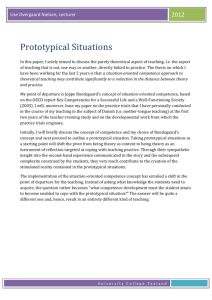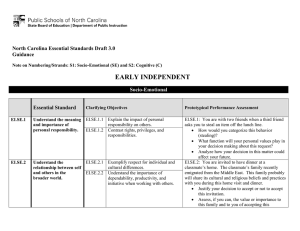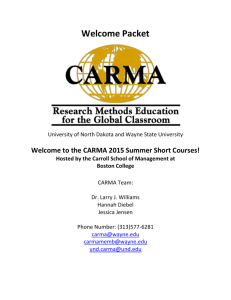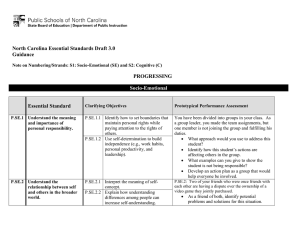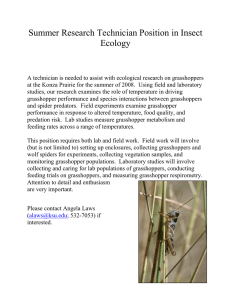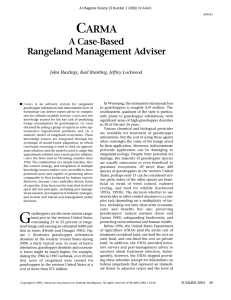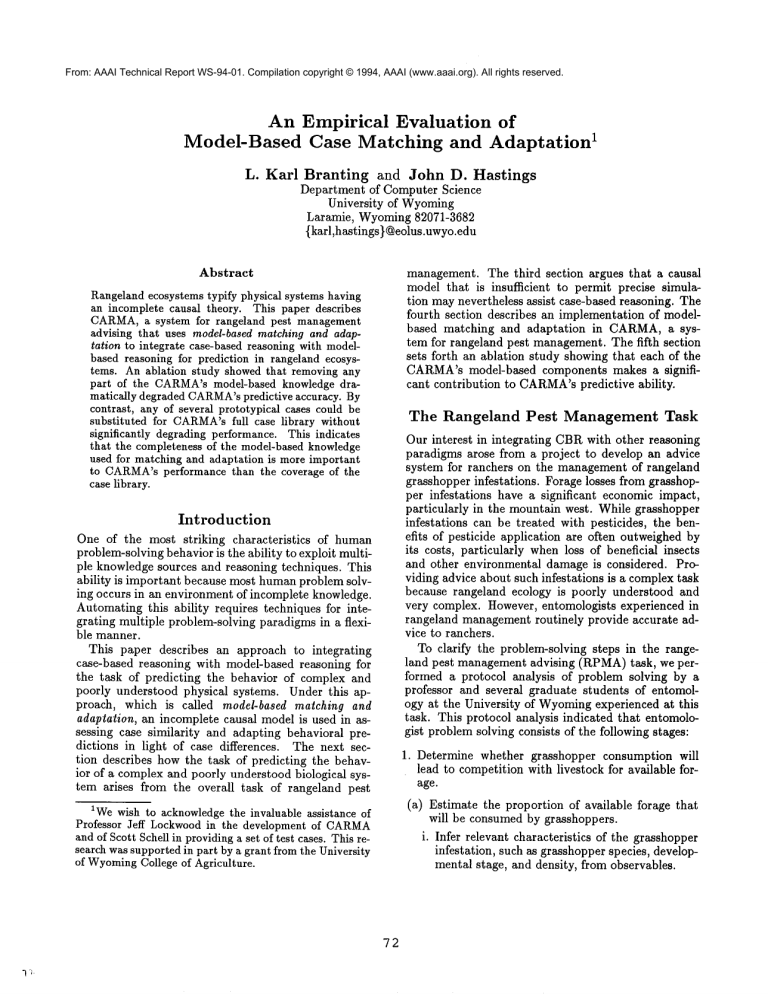
From: AAAI Technical Report WS-94-01. Compilation copyright © 1994, AAAI (www.aaai.org). All rights reserved.
An Empirical Evaluation of
1Model-Based Case Matching and Adaptation
L. Karl Branting and John D. Hastings
Department of Computer Science
University of Wyoming
Laramie, Wyoming82071-3682
{karl,hastings } @eolus.uwyo.edu
Abstract
management. The third section argues that a causal
model that is insufficient to permit precise simulation may nevertheless assist case-based reasoning. The
fourth section describes an implementation of modelbased matching and adaptation in CARMA,a system for rangeland pest management. The fifth section
sets forth an ablation study showing that each of the
CARMA’smodel-based components makes a significant contribution to CARMA’s
predictive ability.
Rangelandecosystems typify physical systems having
an incomplete causal theory. This paper describes
CARMA,
a system for rangeland pest management
advising that uses model-based matching and adaptation to integrate case-based reasoning with modelbased reasoning for prediction in rangeland ecosystems. An ablation study showed that removing any
part of the CARMA’s
model-based knowledge dramatically degraded CARMA’s
predictive accuracy. By
contrast, any of several prototypical cases could be
substituted for CARMA’s
full case library without
significantly degrading performance. This indicates
that the completeness of the model-based knowledge
used for matching and adaptation is more important
to CAI~MA’s
performance than the coverage of the
case library.
The
Rangeland
Pest
Management
Task
Our interest in integrating CBRwith other reasoning
paradigms arose from a project to develop an advice
system for ranchers on the management of rangeland
grasshopper infestations. Forage losses from grasshopper infestations have a significant economic impact,
particularly in the mountain west. While grasshopper
infestations can be treated with pesticides, the benefits of pesticide application are often outweighed by
its costs, particularly when loss of beneficial insects
and other environmental damage is considered. Providing advice about such infestations is a complextask
because rangeland ecology is poorly understood and
very complex. However, entomologists experienced in
rangeland managementroutinely provide accurate advice to ranchers.
To clarify the problem-solving steps in the rangeland pest management advising (RPMA)task, we performed a protocol analysis of problem solving by a
professor and several graduate students of entomology at the University of Wyomingexperienced at this
task. This protocol analysis indicated that entomologist problemsolving consists of the following stages:
Introduction
One of the most striking characteristics
of human
problem-solving behavior is the ability to exploit multiple knowledge sources and reasoning techniques. This
ability is important because most humanproblem solving occurs in an environment of incomplete knowledge.
Automating this ability requires techniques for integrating multiple problem-solving paradigms in a flexible manner.
This paper describes an approach to integrating
case-based reasoning with model-based reasoning for
the task of predicting the behavior of complex and
poorly understood physical systems. Under this approach, which is called model-based matching and
adaptation, an incomplete causal model is used in assessing case similarity and adapting behavioral predictions in light of case differences. The next section describes how the task of predicting the behavior of a complex and poorly understood biological system arises from the overall task of rangeland pest
1. Determine whether grasshopper consumption will
lead to competition with livestock for available forage.
1Wewish to acknowledgethe invaluable assistance of
Professor Jeff Lockwoodin the development of CARMA
and of Scott Schell in providinga set of test cases. This research was supported in part by a grant from the University
of Wyoming
College of Agriculture.
72
(a) Estimate the proportion of available forage that
will be consumed by grasshoppers.
i. Infer relevant characteristics of the grasshopper
infestation, such as grasshopper species, developmental stage, and density, from observables.
ii. Determine the prototypical infestation case that
most closely matches the current case.
iii. Adapt the consumption estimate predicted by
the prototypical case based on the featural differences between the prototypical and current cases.
(b) Compare the grasshopper consumption with the
proportion of available forage needed by livestock.
2. If there will be competition, determine what possible
treatment options are excluded by the conditions of
the case, e.g., rainy conditions preclude the use of
carbaryl bait, environmentalsensitivity precludes all
nonbiological treatments.
Estimate the expected economic costs/benefits
of
.
each acceptable treatment option by determining
the proportion of grasshoppers that would be prevented from further forage consumption and egg laying under each treatment option, estimating the decreased probability of infestation in subsequent years
if a given proportion of grasshoppers were prevented
from laying eggs, and calculating whether the expected value of the benefits of each treatment outweighs its costs.
We have implemented this problem-solving process
in a system termed CARMA
(CAse-based Range Management Adviser). This paper focuses on the components of CARMA
that perform steps l(a)ii and l(a)iii,
estimation of the proportion of available forage that
will be consumed by grasshoppers. Making this estimation requires predicting the behavior of a rangeland
ecosystem, a physical system with an incomplete causal
model.
predator
density
M-
M+
pesticides
attritaon
grasshopper
density
forage
consumption
temperature
M+
immature
stage
pathogen
density
precipitation
forage
\
proportionof
forage consumed
Figure 1: Qualitative relations
tems.
Behavioral
Prediction
with an
Incomplete
Causal
Model
A causal model for the behavior of a physical system
is a model of the interactions among the components
of the system that is capable of predicting or explaining the system’s behavior. While many of the components of a rangeland ecosystem are known, the interactions among these components are only partially
understood.
Figure 1 sets forth the most important of the qualitative causal constraints that influence forage consumption. Other information available for modeling rangeland ecosystems includes the following:
¯ The developmental stages of grasshoppers, including
- The average length of each stage.
- The proportion of lifetime consumption that occurs at each stage.
- The average attrition rate at each stage.
¯ Somespecies of grasshoppers, termed overwintering,
hatch late in the growing season, hibernate during
the winter, and complete their development during the following growing season. Others, termed
nonoverwintering species, hatch, lay eggs and die
within a single growing season.
|M+
range
value
in rangeland ecosys-
¯ The significant production of forage at a location occurs during a specific portion of the growing season,
termed the critical forage growing period, for that
location.
Attempts have been made to construct large-scale
numerical simulation models for grassland ecosystems
(Rodell 1978). While such models often provide insight
into the dynamics of ecosystems (Fedra 1991), there
is a general recognition that the interactions affecting
grasshopper population dynamics are too poorly understood and too complex to permit precise prediction
through numerical simulation (Lockwood & Lockwood
1991; Pimm1991; Allen & Hoekstra 1992).
As mentioned above, our protocol analysis indicated
that part of entomologists’ process of predicting forage consumption consists of comparing a new case to
prototypical infestation cases. This suggests that entomologists use a case-based approach to this task. However, entomologists are capable of generating detailed
causal explanations for their predictions, e.g., in terms
of the qualitative constraints shownin Figure 1. Part
of this ability may come from associating stereotypical explanations with prototypical cases. However,
73
entomologists can easily generate causal explanations
of the effects of incremental variations on case facts.
This strongly suggests that entomologists use the incomplete causal model to adapt and modify predictions
associated with prototypical cases.
In summary,the available causal model of rangeland
population dynamics is insufficient to permit precise
numerical simulation. However, this causal model appears to play an important role in entomologists’ problem solving, both in explanation and in adaptation of
the predictions associated with prototypical cases. Automating entomologists’ problem-solving ability therefore requires a computational mechanismfor integrating this incomplete causal model with case-based reasoning.
Using
Model-Based
Assist
Case-Based
Reasoning
Reasoning
To
CARMA
is a system for advising to ranchers about
rangeland grasshopper infestations.
This section
briefly overviews CARMA’s
case-based reasoning component and describes four different ways in which
CARMA
uses a causal model to assist case-based reasoning: case factoring; temporal projection; featural
adaptation; and critical period adjustment.
Prototypical
Infestation
Cases
Since our protocol analysis indicated that entomologists estimate forage consumption by comparing new
cases to prototypical infestation scenarios, we elicited
a set of prototypical cases from an entomologist experienced at the RPMAtask. These prototypical cases
differ significantly from conventional cases. First, the
prototypical cases are not expressed in terms of observable features (e.g., "WheneverI take a step, I see 4 or
5 grasshoppers with brightly colored wings fly"), but
rather in terms of abstract derived features (e.g., "A
low or moderate density of postwintering grasshoppers
in the pre-adult stage"). Second, since entomologists
see a very large numberof specific cases, the prototypes
represent generalizations of multiple cases, rather than
specific cases. As a result, the feature values of these
cases are often ranges rather than specific values (e.g.,
low to moderate grasshopper densities and normal to
hot temperatures). Finally, the prototypical cases are
extended in time, representing the history of a particular grasshopper population over its lifespan.
CARMA’s
case library currently consists of eight
prototypical cases. Each prototypical case is represented by a "snapshot" at a particular, representative
point in time selected by the entomologist. In general,
this representative time is late enough in the season
that it is possible to determine the extent of the infestation with some certainty, but early enough that
pesticide application is still feasible. Anexampleprototypical case appears as Case8 in Table 1.
74
Case-Based Prediction
Consumption
of Forage
CARMA
begins the process of predicting forage consumption by prompting the user for the observable features of the infestation. A series of rules are used to
infer the relevant case features, such as the species,
density, and developmental stage of the grasshoppers.
Factoring Cases Into Subcases A tract of rangeland often contains multiple, distinct grasshopper populations composed of species whose consumption characteristics vary greatly. Specifically, overwintering
grasshoppers, which divide their consumption between
two growing seasons, consume far less during the
critical forage growing season than nonoverwintering
grasshoppers. CARMA
therefore factors the overall
population of a case into subcases according to wintering types.
CARMA
uses a model of grasshopper developmental
stages to estimate the probable hatch and death dates
of each grasshopper population given the current developmental stage, growing season dates for the location, and current date. If the hatch date occurs before
the current growing season or the death date occurs
after the current season, CARMA
concludes that the
grasshopper population is overwintering. Otherwise,
the population is determined to be nonoverwintering.
For example, the new case set forth in Table 1 is split
into two subcases, SubcaseA and SubcaseB, based on
wintering types.
Temporal Projection To predict the forage loss
of a subcase, CARMA
first retrieves all prototypical
cases whose wintering type matches that of the subcase. Since prototypical cases are extended in time
but are represented at a particular time, matching requires temporally projecting the prototypical cases forwards or backwards to match the average developmental stage of the new subcase. This requires simulating grasshopper attrition,
which depends on developmental stage, precipitation, and developmental speed,
which in turn depends on temperature, throughout the
interval of the projection. An example appears in Figure 2.
The projected prototypical case whose weighted featural difference from the new case is least is selected
as the best match. Feature weights are set using a
hill-climbing algorithm that optimizes CARMA’s
predictive accuracy on training instances. For example,
the prototypical case that best matches SubcaseA after projection is Case8, as shown in Table 1. Because
the developmental stage of Case8 before projection is
later than that of SubcaseA, Case8 must be projected
backwards in time, causing grasshoppers that had been
lost to attrition to be added back to the population.
Temporal projection aligns developmental stages but
not necessarily dates. For example, the date of Case8
after projection is later than the date of SubcaseAbecause the hatch date of Case8 was later than that of
Case8
Wintering type
Feeding types
prewintering
grass 100%
Average stage
Density
Date
Precipitation
Temperatures
Infest. history
Range value
Forage loss
2.0
(rood) = (10
September 8
normal)
normal)
low rood-low rood)
(low rood-low mod)
(low mod-low)
New case
SubcaseA
prewintering
grass 40%
mixed 60%
1.2
13.0
August 20
dry
cool
mod
high-mod
?
SubcaseB
nonoverwintering
grass 100%
7.0
7.0
Case8
after projection
prewintering
grass 100%
1.2
(11.2 15.6
September 2
normal)
normal)
low mod-low mod)
low mod-low mod)
low mod-low)
Table 1: Case examples.
neighborhood of each prototypical case.
Critical
Period Adjustment Consumption is only
damagingif it occurs during the critical forage growing period of a rangeland. The forage loss predicted
by a prototypical case must be modified if the proportion of the lifespan of the grasshoppers overlapping the
critical period differs significantly in the newcase from
the proportion in the prototypical case. This process,
termed critical period adjustment, requires determining the developmental stages of the new and prototypical cases that fall within the critical period and the
proportion of lifetime consumption occurring in these
developmental stages.
An example of critical period adjustment appears in
Figure 3. Because grasshopper development in SubcaseA is ahead of that in Case8 (SubcaseA’s developmental stage on August 20 corresponds to Case8’s
developmental stage on September 2), CARMA
determines that SubcaseA applies to more of the critical
period than Case8 because it will reach stage 5 by the
end of the critical period, while Case8 will only reach
stage 2. CARMA
uses a model of grasshopper’s rate
of consumption at each developmental stage to calculate the proportion of lifetime consumption occurring
before the end of the critical period. For example, 47%
of SubcaseA’s consumption occurs during the critical
period, whereas only 6% Case8’s consumption occurs
within this period. CARMA
therefore scales the initial
consumption estimate by (47 / 6) = 7.8.
After adaptation, the consumption predictions for
each subcase (i.e., behaviorally distinct population
of grasshoppers) are summed to produce an overall consumption estimate. In the given case, the
sum of predicted consumption of the two subcases is
high-moderat
e.
In summary, CAI~MAuses model-based reasoning
in four different ways to assist case-based reasoning.
First, a model of grasshopper developmental stages is
used to estimate probable hatch and death dates in
Density
NC
PC
[ }D
Hatch
Adult
Averagestage
Figure 2: Projection of a prototypical case from PC
to PC’ to align its developmental stage with new case
NC.
SubcaseA. As a result, the developmental stage of the
grasshoppers in SubcaseA on August 20 are the same
as those of Case8 two weeks later on September 2.
Featural Adaptation The consumption predicted
by the best matching prototypical case is modified to
account for any featural differences between it and the
subcase. This adaptation is based on the influence of
each feature on consumption as represented by global
feature weights. For example, a lower temperature
value means lower forage losses, because lower temperatures tend to slow developmental speed, increasing
grasshopper attrition. Thus, the forage loss estimate
predicted by Case8--(low mod-low)--must be adapted
downwardsomewhat to account for the fact that temperatures in SubcaseA (cool) are lower than in Case8
(normal).
The feature weights used in featural adaptation constitute a linear approximation of the function from
derived case features to consumption amounts in the
75
$ubcasoA
¯
gnd
:
Begin
CARMA
used the same global feature weights and case
library as the full system.
ID3 was given ProtoL and Setl as training instances. Because prototypical case features contain
ranges, cases in ProtoL were treated as pairs of cases
with the feature values associated with the minimum
and maximum
forage loss predictions of each prototypical case.
The linear approximation approach consists of a linear equation for forage consumption as a function of
case feature values represented in quantitative terms.
The coefficients of this equation were found using QR
factorization (Hager 1988) to find a least-squares fit
to the feature values and associated predictions of the
cases in Setl and ProtoL. As with ID3, ProtoL cases
were treated as consisting of two cases corresponding
to the minimumand maximumforage loss predictions
of each prototypical case.
The single case library approach was evaluated by
testing CARMA
with the full case library replaced by
individual members of ProtoL. These tests used the
same global feature weights as the full system.
The accuracy of each approach was tested by comparing its forage loss prediction for each case in Set2
with the prediction of the expert. The qualitative difference between two forage loss predictions was calculated as the number of categories by which the predictions differin theorderedset {low,low-moderate,
moderate,high-moderate,
and high},so that low
differs
fromhighby fourcategories,
themaximum
possiblequalitative
difference.
Theresults,
whichappear
inTable2, include
thetotalqualitative
error(qualitativedifference
between
theprediction
of theapproach
andtheexpert
overallthetestcases),
thetotalnumberof incorrect
predictions,
andtheaverage
qualitative
error
pertestcase.
Becausethemaximumpossible
qualitative
erroris
four(e.g.,
lowinstead
of high),
a constant
prediction
of moderate
consumption
couldneverbe off by more
thantwoqualitative
categories.
A constant
prediction
of moderate
is included
forpurposes
of comparison.
PromA
’I~e
Critical growing
Ironed
Figure 3: Critical
SubcaseA.
period adjustment from Case8 to
order to factor the new case into behaviorally distinct
subcases. Second, a model of grasshopper attrition is
used in temporal project to simulate the attrition that
would have occurred during the interval between the
date of the new case and the representative date of
the prototypical case. Third, featural adaptation constitutes a linear approximation of the function from
derived case features to consumption amounts in the
neighborhood of each prototypical case. Finally, critical period adjustment modifies the prediction estimate
to take account of any difference in overlap between
grasshopper lifespans and the critical forage growing
season.
Evaluation
Weperformed an evaluation to determine the relative
contribution of empirical (i. e., case-based) and modelbased knowledge to the performance of CARMA’s
consumption prediction module. To determine the contribution of model-based knowledge, we performed an
ablation study in which the performance of the full
CARMAconsumption prediction
module was compared to the performance of CARMA
with various
model-based components removed and to two different inductive methods: ID3 (Quinlan 1986) and leastsquares linear approximation. To determine the contribution of empirical knowledge, the performance of
CARMA
was tested with the full multiple case library
replaced with single case libraries.
The experimental case sets included ProtoL, Setl,
and Set2. ProtoL is a library of eight prototypical cases
generated by an entomologist, consisting of two overwintering cases and six nonoverwintering cases. Setl
consists of 15 cases generated by the same entomologist. Set2 contains 48 test cases whose features were
randomly generated and whose forage loss predictions
were estimated by a second entomologist.
Experimental
Discussion
CARMA’s
average qualitative error was .42, as compared to an average error of 1.67 for a constant prediction of moderate consumption. 1 Removal of modelbased knowledge significantly
degraded CARMA’s
performance. CARMA’s
error rate was almost doubled by
removal of featural adaptation (.79), removal of projection and critical period adjustment (.83), or by removal of all three (.85). CARMA
was not tested with
case factoring disabled. However, ID3’s performance
on unfactored cases, 1.00, was lower than CARMA’s
Design
CARMA
was tested using ProtoL as its case library.
CARMA’sglobal feature weights, used both in case
matching and in adaptation, were tuned using a hillclimbing algorithm to optimize CARMA’s
overall predictive accuracy on Setl. The ablated versions of
1This error for a constant prediction is higher than the
value expectedif the expert predictions were uniformlydistributed across the five qualitative categories. However,
the expert predictions were skewedtowards high and low
predictions.
76
Total error Total number Average error
(qualitative)
incorrect
(qualitative)
CARMA
20
15
.42
Constant pred.
80
46
1.67
Ablation of Model-Based Knowledge
CARMA w/o FA
38
23’
.79
4O
24
.83
CARMA w/o CPA,p
41
28
.85
CARMAw/o FA,CPA,P
ID3
28
1.00
48
Linear approx.
57
23
1.15
Reduced Case Library
Cas’el
39
27
.81
Case2
65
26
1.35
Case3
23
17
.48
Case4
50
29
1.04
Case5
25
1.60
77
Case6
23
15
.48
Case7
25
18
.52
Case8
24
15
.50
"’’
4’{).8
Average
21.5
.85
Table 2: Summaryof test results.
adjustment, respectively.
P, FA, and CPArepresent projection,
performance with all model-based reasoning other than
case factoring disabled, suggesting that case-factoring
is also an important requirement for performance in
this domain.
Featural adaptation assumes that the function for
forage consumption can be approximated by a linear
equation in the neighborhood of prototypical cases.
Given the large contribution of featural adaptation to
CARMA’s
performance, it seems reasonable to wonder
whether the forage consumption function can be globally approximated by a linear equation. However, the
performance of the linear approximation (1.15) indicates that a linear function for consumption as a function of case features is a poor predictor.
The results of the reduced case library tests surprisingly indicate that a CARMA
case library consisting of
only Case6 or Case8 produced as many correct predictions as a library containing the multiple prototypical
case set ProtoL, although the average qualitative error
is slightly higher. One contributor to this high performance may be that the prototypical cases have ranges
of values for many features and therefore effectively
represent multiple cases. However,this result indicates
that the completeness of the model-based knowledge
used for matching and adaptation is more important to
CARMA’sperformance than the coverage of the case
library.
The effectiveness of model-based adaptation is illustrated particularly vividly by the fact that a case library consisting solely of Case8 performed nearly as
well as the full case library. This result was unex-
featural
adaptation, and critical
period
pected because Case8 is an overwintering prototypical
case with low predicted consumption (because most
of the lifespan of the grasshoppers occurs outside of
the critical forage growth period), while most of the
cases in Set2 contain nonoverwintering grasshoppers
with much higher predicted consumption.
Future
Work
The most important weakness of the current implementation of CARMA’s
forage consumption prediction
module is that it uses a single set of global feature
weights for matching and for featural adaptation. Even
if the consumption function can be approximated by
a linear function in the neighborhood of prototypical
cases, as assumedin featural adaptation, it doesn’t follow that the same linear function is appropriate for all
prototypical cases. Indeed, the observed poor performance of global linear approximation, shown in Table
2, suggests that linear approximations, and therefore
feature weights, should be specific to individual prototypical cases. Moreover, while it is plausible that
feature weights for matching should be the same as
feature weights for adaptation, this hypothesis has not
been tested, Thus, an important piece of future work is
to test case-specific adaptation and matching feature
weights.
An important limitation of the evaluation reported
here is that the consumption predictions associated
with Set2 was produced by a different entomologist
than the entomologist from whomthe prototypical
77
cases were elicited. As a result, there may be inconsistencies between the testing set and the library of
prototypical cases. Wehave subsequently obtained a
set of 32 test cases produced by USDAentomologists
experienced in this task and by the entomologist who
was the source of the prototypical cases. This should
permit a more reliable evaluation of CARMA’sconsumption estimation module.
Related
ing any of the latter three model-based mechanisms
dramatically degraded CARMA’s
predictive accuracy.
Moreover, CARMA
performed significantly better with
temporal projection, featural adaptation, and critical
period adjustment removed than inductive approaches
(ID3 and linear approximation) trained on unfactored
cases, strongly suggesting that case factoring is also an
important contributor to CARMA’sperformance.
However, any of several prototypical cases could be
substituted for CARMA’s
full case library without significantly degrading performance. This indicates that
the completeness of the model-based knowledge used
for matching and adaptation is more important to
CARMA’sperformance than the coverage of the case
library.
Work
Several previous research projects have investigated
the benefits of integrating case-based reasoning with
model-based reasoning. However, these projects have
generally assumed the existence of a correct and complete causal model. For example, CASEY(Koton
1988) performed diagnosis using model-based reasoning to assist both case matching and case adaptation.
However, CASEYpresupposed both the existence of
a complete causal theory of heart disease and complete explanations of each case in terms of that theory. Because the causal model in CARMA’sdomain
is insufficient for accurate prediction and the causal
explanations associated with cases are incomplete, the
assumptions underlying CASEY’smatching and adaptation strategies are inapplicable to CARMA’s
domain.
Rajamoney and Lee (Rajamoney & Lee 1991) used
a different approach to integrating case-based reasoning with model-based reasoning termed prototype-based
reasoning. This approach uses a library of prototypes to decompose problems into familiar subproblems. Model-based reasoning is applied to the subproblems, a consistent composition of the subproblems is determined, and model-based reasoning is applied to determine the behavior of the resulting simplified model. As with CASEY,this approach presupposes a complete and correct (though not necessarily
tractable) causal model. Similarly, Goel and Chandrasekaran’s approach of using device models to adapt
design cases presupposes that the device models are
complete and correct (Goel & Chandrasekaran 1989).
Feret and Glascow (Feret & Glascow 1993) describe
an alterative approach under which model-based reasoning is used for "structural isolation", i.e., identification of the structural componentsof device that probably give rise to the symptomsof a fault. Cases are indexed by these tentative diagnoses, which are then refined using case-based reasoning. This approach, while
appropriate for diagnosis, is ill-suited for behavioral
prediction in the absence of faults.
References
Conclusion
This paper has described CARMA,
a system that integrates case-based reasoning with model-based reasonmg for prediction in rangeland ecosystems. CARMA
uses four different mechanismsfor model-based matching and adaptation: case factoring; temporal projection; featural adaptation; and critical period adjustment. An empirical evaluation showed that remov-
78
Allen, T. F. H., and Hoekstra, T. W. 1992. Toward a
Unified Ecology. NewYork, NY: Columbia University
Press.
Fedra, K. 1991. Interactive modeling of environmental impacts. In Proceedings of Automatic Control:
Triennial World Congress, 521-527.
Feret, M. P., and Glascow, J. I. 1993. Hybrid casebased reasoning for the diagnosis of complexdevices.
In Proceedings of Eleventh National Conference on
Artificial Intelligence, 168-175. Washington, D.C.:
AAAI Press/MIT Press.
Goel, A., and Chandrasekaran, B. 1989. Use of device
models in adaptation of design cases. In Proceedings
of the Second DARPACase-Based Reasoning Workshop. Morgan Kaufmann.
Hager, W. 1988. Applied Numerical Linear Algebra.
Prentice Hall.
Koton, P. 1988. Using Experience in Learning and
Problem Solving. Ph.D. Dissertation, Massachusetts
Institute of Technology. Department of Electrical Engineering and Computer Science.
Lockwood, J., and Lockwood, D. 1991. Rangeland
grasshopper (orthoptera: Acrididae) population dynamics: Insights form catastrophe theory. Entomological Society of America 970-980.
Pimm, S. L. 1991. The Balance of Nature: Ecological
Issues in the Conservation of Species and Communities. Chicago: University of Chicago Press.
Quinlan, J. R. 1986. Induction of decision trees. Machine Learning 1:81-106.
Rajamoney, S., and Lee, H. 1991. Prototypebased reasoning: An integrated approach to solving
large novel problems. In Proceedings of Ninth National Conference on Artificial Inlelligence. Anaheim:
AAAIPress/MIT Press.
Rodell, C. F. 1978. Simulation of grasshopper populations in a grassland ecosystem. In Innis, G. S.,
ed., Grassland Simulation Model. New York, NY:
Springer-Verlag. 127-154.

